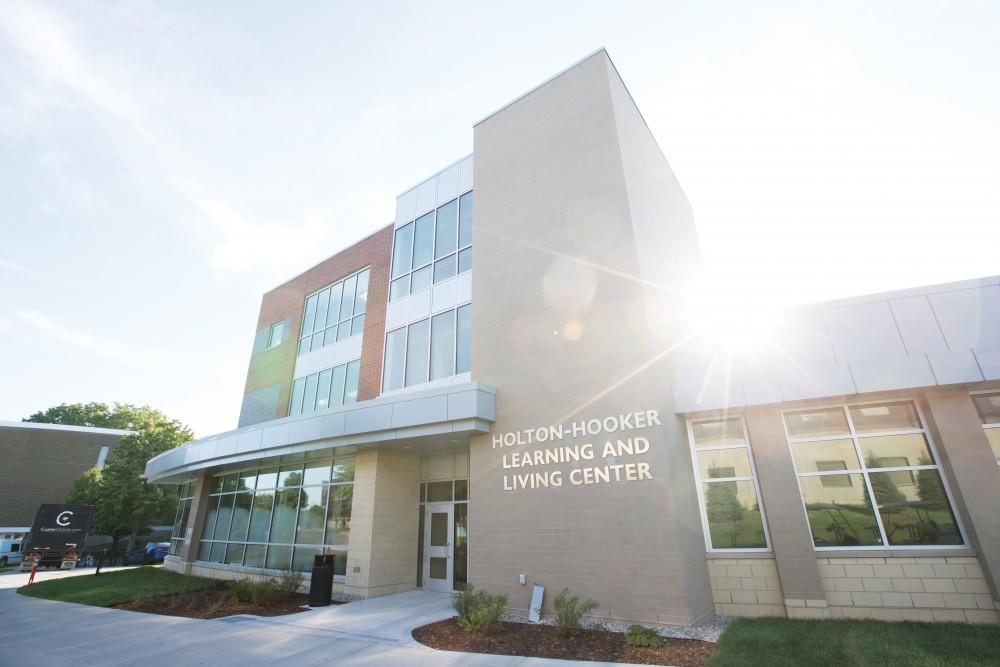Promoting sustainability

GVL/Kevin Sielaff – The Holton-Hooker Living Center, as pictured on Thursday, Aug. 18, 2016.
Feb 23, 2017
Grand Valley State University has 24 LEED-certified sites and structures totaling 1.7 million square feet, and newly added to that list is the Holton-Hooker Learning and Living Center. LEED, or Leadership in Energy and Environmental Design, is a designation given to buildings and communities that commit to sustainable progress through design and construction innovation.
Holton-Hooker recently received the LEED Silver certification from the U.S. Green Building Council, contributing to the 39 percent of GVSU facilities that are at the Silver Level of this designation.
Andy Beachnau, associate vice provost for student services and director of housing and health services, explained this designation is part of GVSU’s mission to construct buildings that are environmentally sustainable.
“Grand Valley decided several years ago that if we’re going to do buildings, they may cost us a little bit more in the beginning, but over time they will be more sustainable,” Beachnau said.
In order for the LEED certification to be applicable to a building, a multitude of factors are considered. A building or structure must be environmentally sustainable when it comes to its water efficiency, the materials and resources used to build the edifice, the site sustainability, the utilization of natural lighting and the environmental quality and innovation in the design.
Beachnau said when GVSU constructs a building or structure, there is significant motivation to make it as eco-friendly and sustainable as possible. Not only that, but the designation sends a message to the community that GVSU is a leader when it comes to environmentally sustainable buildings.
“If we are going to put up a building, we want it to be efficient and friendly, and at the same time, we want to say something to the larger community that the environment matters and that we are leaders,” Beachnau said. “It fits with the whole Laker theme. It’s a value of Grand Valley that when we do buildings, we want to be in the elite status.”
LEED certifications are applicable to all types of buildings during different phases of development. When a project is underway with an LEED certification in mind, the project will earn points in different subcategories in sustainability issues. Based on the amount of points received, the project will then receive one of the four LEED designations, if applicable: Certified, Silver, Gold or Platinum.
Karen Ingle, project manager of GVSU Facility Planning, said when it came to the design of the Holton-Hooker resident building, there was great consideration taken to the design of the building as well as how to make it better for the environment and the students living there.
“The design includes innovative solutions that are better for the environment, make efficient use of resources and result in an energy and water efficient building,” Ingle said. “By selection of low VOC materials, lighting and temperature controls, increased ventilation and day lighting, the indoor environmental quality is improved for better comfort, health and productivity.”
In the case of GVSU’s buildings and structures that have LEED certification, five percent of GVSU facilities are at Certified Level, 39 percent are at Silver Level, 47 percent are at Gold Level and nine percent are at Platinum level. In total, GVSU has constructed 94 percent of their new space to LEED standards, and 35 percent of GVSU’s total university spaces are LEED-certified buildings.
Holton-Hooker not only has LEED Silver status but is also home to 500 students with 240 tradition-style bedroom units, three classrooms, three faculty offices and a computer lab. It also has a game room, outdoor recreational space, study spaces and laundry facilities.

























